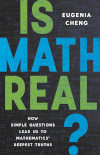- About MAA
- Membership
- MAA Publications
- Periodicals
- Blogs
- MAA Book Series
- MAA Press (an imprint of the AMS)
- MAA Notes
- MAA Reviews
- Mathematical Communication
- Information for Libraries
- Author Resources
- Advertise with MAA
- Meetings
- Competitions
- Programs
- Communities
- MAA Sections
- SIGMAA
- MAA Connect
- Students
- MAA Awards
- Awards Booklets
- Writing Awards
- Teaching Awards
- Service Awards
- Research Awards
- Lecture Awards
- Putnam Competition Individual and Team Winners
- D. E. Shaw Group AMC 8 Awards & Certificates
- Maryam Mirzakhani AMC 10 A Awards & Certificates
- Two Sigma AMC 10 B Awards & Certificates
- Jane Street AMC 12 A Awards & Certificates
- Akamai AMC 12 B Awards & Certificates
- High School Teachers
- News
You are here
Is Math Real?

Publisher:
Basic Books
Publication Date:
2023
Number of Pages:
336
Format:
Hardcover
Price:
30.00
ISBN:
978-1541601826
Category:
General
[Reviewed by , on ]
Tom French
09/4/2023
I settled in to read the book “Is Math Real?” expecting to become embroiled in the age-old controversary of whether math is invented or math is discovered. Instead, I found myself confronted with two viewpoints of mathematics: one view is that mathematics is a stiff and fixed set of rules and algorithms while the other view is that mathematics is flexible and our understanding of math comes from questioning of why mathematics functions so effectively.
The premise of “Is Math Real?” is that people have different emotions about math. Some love the math and have little difficulty determining the correct answer to a problem while others loathe and dislike the math and have a difficult time ascertaining the correct response. Many times, a student is humbled or chastised for asking ‘a stupid question’. Author Cheng states that there are no stupid questions. In fact, the most profound concepts in mathematics are learned from asking the simplest of questions. As teachers and professors of math, we should welcome all questions and understand that answering questions is what helps students learn.
The theme of this book is the denunciation of math being taught in a rigid and inflexible way. Oftentimes, math is taught as a set of rules and processes divined from an authority in which learners must memorize the rules and strictly follow the processes in order to satisfactorily find the one and only correct answer. Our author clearly states that math is not a fixed set of algorithms, but rather, math is the study of how logical things work.
There is an intriguing discussion in Chapter 3, entitled ‘Why We Do Math’, that presents three reasons why math is an important part of education: 1) math is directly useful to resolve calculation problems; 2) math is needed to study further in a variety of subjects such as science, engineering, or medicine; and 3) math has an indirect usefulness which is a way of thinking that is transferable to a myriad of disciplines and solutions to problems in everyday life. And it is this third reason that makes math relevant for most people. For example, the lessons learned in geometry are more than just about triangles … they are about critical thinking and laying out logical arguments. So that the lessons learned in geometry class prove instrumental for a Ph.D student studying microeconomics as well as the person sewing together drapes to make patterns fit together in a systematic way.
“Is Math Real?” treats mathematical topics in a unique and original way. Discussions on number patterns, Platonic solids, math history, ethnomathematics, and mathematical structures presents the reader with a plethora of ideas on how one can envision mathematics.
The question “is math real?” is answered in the epilog of this book. Cheng tells us that math is real because it is an idea and ideas are real.
Tom French has a B.S. and a M.S. degree in Mathematics from Minnesota State University, Mankato. He has 35 years of engineering and business experience with UNIVAC and its successor companies. He has lectured on mathematics and computer systems throughout the world and has taught mathematics at a number of US colleges and universities.
See the publisher's website.
- Log in to post comments




